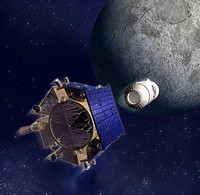Nasa's Spacecraft Hits "Dry Hole" on Moon
Nasa's 'moon bombing' mission with the LCROSS spacecraft to strike a moon crater in order to collect frozen water, may have struck a 'dry hole'. After the low-impact collision there were no plumes of dust and ice.

According to a report in National Geographic News, NASA's Lunar Crater Observation and Sensing Satellite mission sent two spacecraft 'bombing' into the moon on October 9.
The craft successfully struck their target, a crater thought to harbour frozen water.
But, the much-hyped moon show that had been expected to accompany the impact, however, turned out to be a flop, as no billowing plumes of dust and ice were visible through backyard telescopes or on NASA TV.
At 7:31 am ET on October 9, a 2.2-ton empty rocket shot from the LCROSS probe hit the crater Cabeus A on the moon's South Pole.
Four minutes later, LCROSS performed its own kamikaze dive, which was the final act in its mission to detect evidence of water ice in the moon's shadowed craters.
Whether or not sky-watchers could see the LCROSS crashes, NASA insists they happened, Rediff reports.
It was also reported, Nasa's LCROSS spacecraft travelled towards the moon at more than 9,000 kilometres per hour on Friday afternoon. It tweeted in the whale's words: "And what's this thing coming toward me very fast? So big and flat and round ... it needs a big wide sounding name like 'Ow', 'Ownge', 'Round', 'Ground'! ... That's it! Ground! Ha! I wonder if it'll be friends with me?"
Then it crashed into the moon, unfortunately failing to produce the 10km plume of dust and rock which could have been scanned for evidence of frozen water. Nasa made no mention of Adams's bowl of petunias, which thought only "Oh no, not again" as it tumbled towards Magrathea.
"Many people have speculated that if we knew exactly why the bowl of petunias had thought that we would know a lot more about the nature of the universe than we do now," wrote Adams in 1979.
The 30th anniversary of The Hitchhiker's Guide has also been marked with the publication of a sixth book in Adams's series, written by children's author Eoin Colfer with the blessing of Adams's widow, Jane Belson, and published today. And Another Thing ... picks up from where Adams's Mostly Harmless ended, and has been heralded as a triumph, guardian.co.uk reports.
News agencies also report, LCROSS spacecraft have taken their fatal plunge into the lunar polar crater Cabeus as planned, and excavated a much smaller ejecta plume than many had anticipated. Given the weakness of this signal, it will probably be some time before we know what the water composition of this material might be. If it is high, in the range of a percent or more, this bodes well for a model in which water permeates the soil to significant depth, as indicated by the internal-origin option. Of course water vapor seeping to the surface might be patchy, as it is for volcanic processes on Earth. If we see little water, we can't be sure of what it tells us. We may have just hit the wrong patch, The Space Review reports.
Subscribe to Pravda.Ru Telegram channel, Facebook, RSS!


